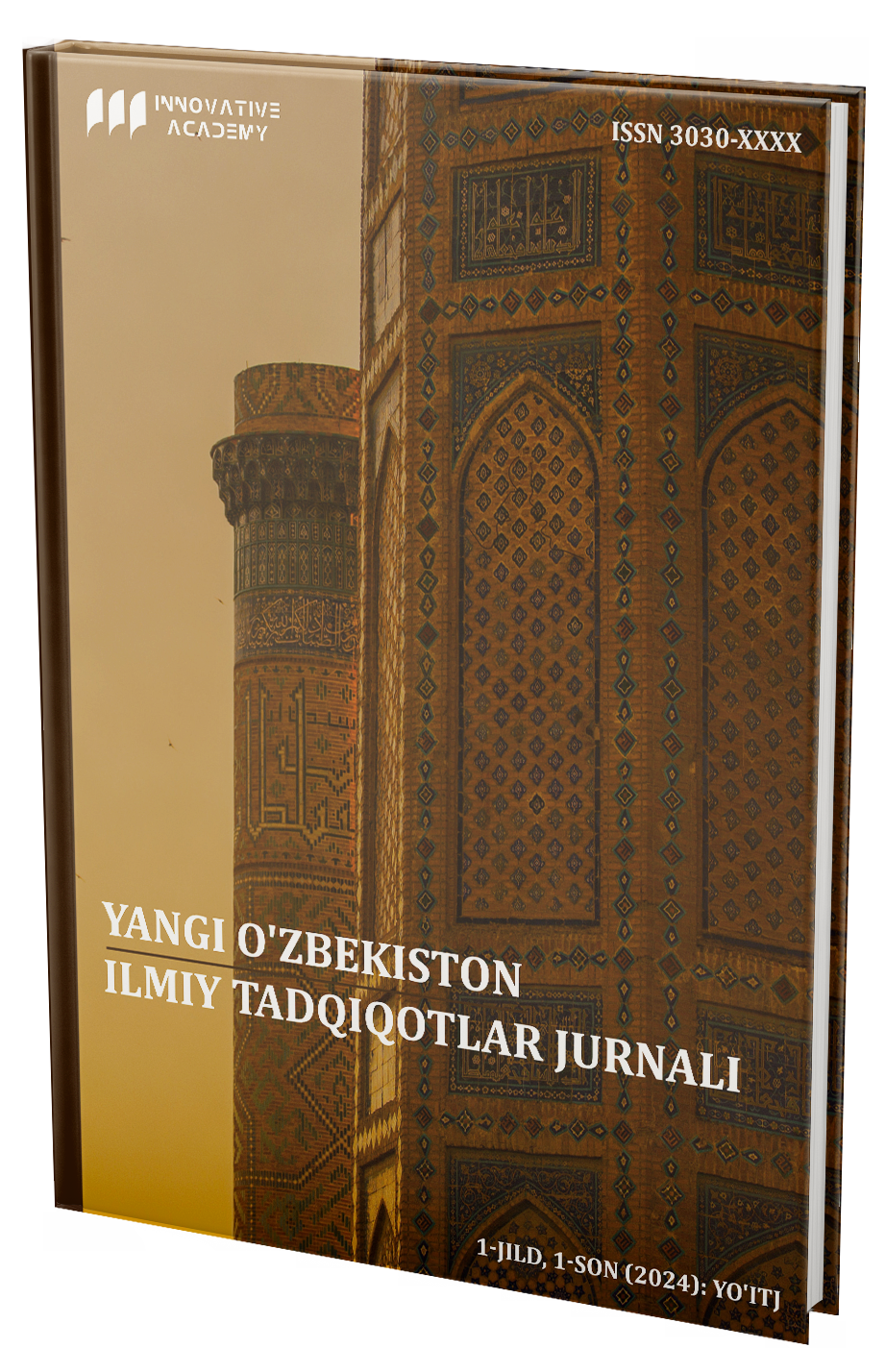FLAVANOIDLAR HÁM OLARDIŃ TÁSIR ETIW MEXANIZMLERI
Main Article Content
Аннотация:
Izertlewshilerdi ózine qızıqtırıp kelgen biologiyaliq aktiv birikpeler bolǵan flavanoidlar júdá kóplegen strukturalıq hám potencial farmakologiyaliq qollanılıwına iye bolǵan eń áhmiyetli metabolitlerden bırı bolıp esaplanadi. Házirgi waqıtqa shekem 10000 ǵa jaqın flavanoidlar ósimliklerden ajratıp alınǵan hámde awqatlıq zatlarda qollanılatın ónimler quramında da ushrasadı. Flavanoidlardıń funksiyası, tásir etiw mexanizmlerin, qásiyetlerin úyreniw úlken áhmiyetke iye. Sol sebepli bul maqalada flavanoidlar haqqında eń sońǵi jańa maǵliwmatlar keltirilip ótiledi.
Article Details
Как цитировать:
Библиографические ссылки:
A.D. McNaught and A. Wilkinson. IUPAC Compendium of Chemical Terminology 2nd Edition Blackwell. Scientific Publıcations, Oxford, 1997.
A.N.Panche, A.D.Dıwan and S.R.Chandra. Flavonoids: an overview, Journal of Nutritional Science vol. 5, page 1 of 15, 2016.
Alvarez-Suarez.J, Giampieri.F, Cordero.M, Gasparrini.M, Forbes-Hernández.T, Mazzoni.L, Afrin.S, Beltrán-Ayala. P, González-Paramás. A, Santos-Buelga.C and et al. Activation of AMPK/Nrf2 signallıng by Manuka honey protecc human dermal fibroblasc against oxidative damage by improving antioxidant response and mitochondrial function promotıng wound healıng. J. Funct. Foods 2016, 25, 38–49. [CrossRef].
Bhagwat S, Haytowitz.D.B, Holden.J.M, USDA Database for the Flavonoid Content of Selected Foods, Release 3.1; US Department of Agriculture: Belcville, MD, USA, 2014. 48, 37.
Brodowska, K. M. (2017). Natural flavonoids: classification, potential role, and applıcation of flavonoid analogues. European Journal of Biological Research, 7 (2), 108-123. https://doi. org/10. 5281/zenodo. 545778
Cao G, Sofic E, Prior.R.L, Antioxidant and prooxidant behavior of flavonoids: Structure-activity relationships. Free Radıc Biol Med. 1997, 22, 749–760. [CrossRef].
Chen S, Wang X, Cheng Y, Gao H, Chen X. A Review of Classification, Biosynthesis, Biological Activities and Potential Applıcations of Flavonoids. Molecules. 2023 Jún 25;28 (13):4982. doi: 10. 3390/molecules28134982. PMID: 37446644; PMCID: PMC10343696.
Engelkemeir D.W, Geissman T.A, Crowell W.R, Friess S.L, Flavanones and related compounds. IV. the reduction of some naturally-occurring flavones at the dropping mercury electrode. J Am Chem Soc 1947;69:155–9. doi: https://doi. org/10.1021/ja01193a042.
Fraga C, Plant polyphenols: How to translate their in vitro antioxidant actions to in vivo condıtions. Iubmb Lıfe 2007, 59, 308–315. [CrossRef].
Geissman T.A, Mehlquist G.A, Inheritance in the carnation, Dianthus caryophyllus. IV. the chemistry of flower color variation, I. Genetics 1947;32:410–33. [doi: https://doi.org/10.1093/genetics/32.4.410.].
Gupta M, Mishra A. Bioactive Flavonoids: A comparative overview of the biogenetic and chemical synthesis approach. Mini Rev Med Chem 2023;23. doi: https://doi.org/10.2174/1389557523666230214101821.
Hinreiner G.E, Theories of the biogenesis of flavonoid compounds. Bot Rev 1952;18:77–164. [doi: https://doi.org/10.1007/BF02960588].
Kicinska A, Jarmuszkiewicz W. Flavonoids and Mitochondria: Activation of Cytoprotective Pathways? Molecules. 2020 Jul 4;25(13):3060. doi: 10.3390/molecules25133060. PMID: 32635481; PMCID: PMC7412508].
Kuo Xu, Xia Ren, Jintao Wang, Qin Zhang, Xianjun Fu, Pei-Cheng Zhang, Clınical development and informatics analysis of natural and semi-synthetic flavonoid drugs: A critical review, Journal of Advanced Research, 2023,,ISSN 2090-1232,https://doi.org/10.1016/j.jare.2023.11.007.
McAnlıs G, McEneny J, Pearce J, Young I, Absorption and antioxidant effect of quercetın from onions, in man. Eur. J. Clın. Nutr. 1999, 53, 92–96. [CrossRef].
Miyagi Y, Miwa K, Inoue H, Inhibition of human low-density lıpoprotein oxidation by flavonoids in red wine and grape juice. Am. J. Cardıol. 1997, 80, 1627–1631. [CrossRef].
Murota K, Nakamura Y, Uehara M, Flavonoid metabolısm: The interaction of metabolites and gut microbiota. Biosci. Biotechnol. Biochem. 2018, 82, 600–610. [CrossRef].
Perez, C.A.; Wei, Y.; Guo, M. Iron-bindıng and anti-Fenton properties of baicalein and baicalın. J. Inorg Biochem. 2009, 103, 326–332. [CrossRef] [PubMed].
Sandoval-Acuña C, Ferreira J, Speisky H, Polyphenols and mitochondria: An update on their increasingly emerging ROS-scavenging independent actions. Arch. Biochem. Biophys. 2014, 559, 75–90. [CrossRef].
Sichel G, Corsaro C, Scalia M, Di Bilio.A.J, Bonomo, R.P, In vitro scavenger activity of some flavonoids and melanins against O2 −dot . Free Radıc Biol Med. 1991, 11, 1–8. [CrossRef].
Taraxovskiy Yu.S, Kim Yu.A, Abdrasilov B.S, Muzafarov Ye.N, Flavonoidi: bioximiya, biofizika, medıcina, [otv. red. Ye. I. Maevskiy]-Pushıno: Sunchrobook.
Xiao J, Kai G, Yamamoto K, Chen X, Advance in dietary polyphenols as alpha-glucosidases ingibitors: A review on structure-activity relationship aspect. Crit. Rev. Food Sci. Nutr. 2013, 53, 818–836. [CrossRef].


